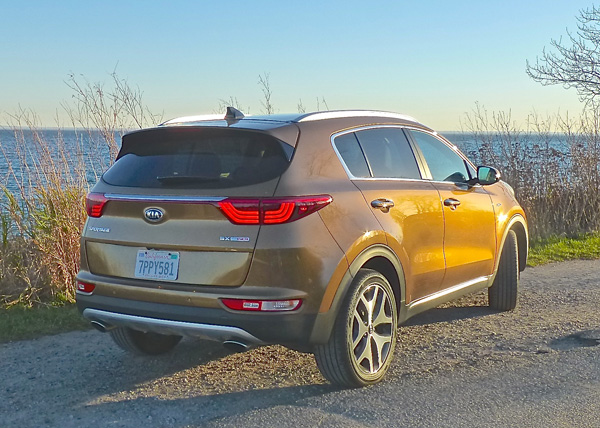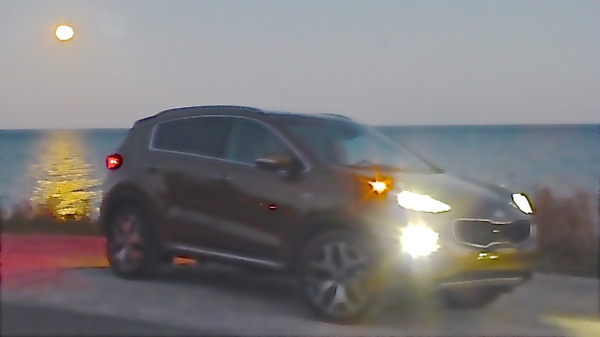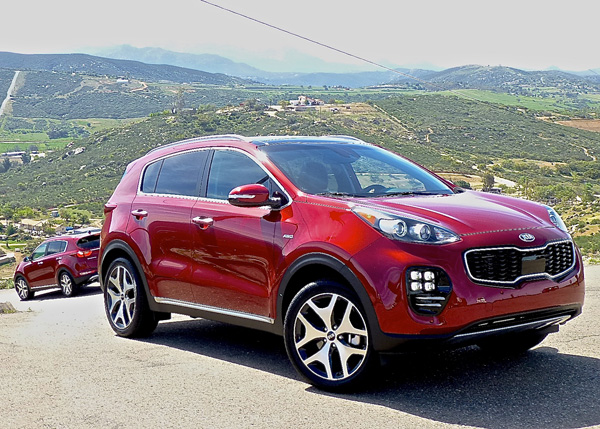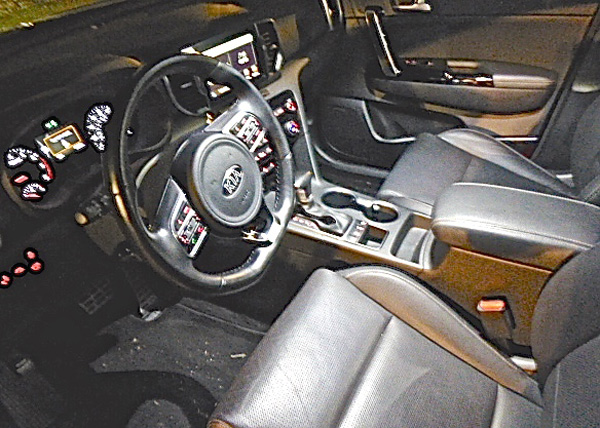News & Articles
Browse all content by date.

Compact crossover SUVs are the rage in automotives, in case you hadn’t noticed, and finally we’ve got a trend that makes sense. If larger or midsize SUVs have more space than cars, they also cost more money, require larger engines and therefore suffer when it comes to fuel economy, and are more difficult to drive in congested traffic.
Continuing the trend from large SUVs to midsize, to compact makes great sense. If the room is adequate, generally better than the largest sedans, the more compact size leads to sportier handling with smaller, peppier and more fuel-efficient engines. A perfect example is the 2017 Kia Sportage, the more compact sibling to the Sorento, Kia’s offering in the larger midsize-to-full-size category.
Hyundai took over Kia almost a decade ago, and the two have been raised as parallel companies, both benefitting by the other’s successes. Hyundai was on the verge of an engineering breakthrough, and Kia came along with some equally brilliant design ideas. That helped make it more of a merger than a takeover, and both kept turning out exceptional vehicles from the smallest compact cars up through luxury vehicles, and with SUVs that filled all the required gaps.

During recent new-vehicle introductions by both Hyundai and Kia, I asked executives of both South Korean partners if they were concerned about too much similarity in their parallel models. They agreed, but pointed out that steps were being taken to differentiate them.
Their timing couldn’t have been better than with the compact crossover SUV battles becoming perhaps the most intense in the industry. While Kia’s Sorento competes with Hyundai’s Santa Fe, its Sportage takes on Hyundai’s Tucson. Both are sophisticated compact crossovers, and while they share the same platform, they split apart when it comes to powertrains, and design.

The Tucson came out all new for 2016, and it is an outstanding vehicle, powered by either a 2.0-liter 4-cylinder, or a newly turbocharged 1.6-liter that is smaller in displacement but bigger in horsepower and torque.
Kia waited its turn to allow the Tucson its time in the spotlight, and for the 2017 model year, the all-new redesigned Sportage hits the marketplace with distinctive differences in purpose. Where the Tucson is mainstream/family oriented, the Sportage is built to look and be sportier. The Sportage uses the larger 2.4-liter engine with 181 horsepower and 175 foot-pounds of torque for snappy everyday use. But moving up to the sportiest SX model, it turbocharges the 2.0-liter 4-cylinder from the base Tucson, boosting its horsepower to a neck-snapping 240, with 260 foot-pounds of torque -- up nearly 80 horses and nearly 90 foot-pounds above the normally-aspirated 2.0.

At the introduction of the new Sportage, we drove various models up into the California hills, using mostly the front-wheel-drive models. I stressed that anyone in Duluth, Minnesota, buying an SUV of large, medium, compact, or small without all-wheel drive would require counseling. My pleas didn’t get me any more time in the AWD version I wanted at the introductory drive, but Kia came through by sending a Sportage SX out of its press fleet for me to use for a week to challenge the hillsides.
It was no challenge. The 6-speed automatic transmission worked well, particularly with the steering-wheel paddles that add to the sporty flair of the Sportage. While they make it fun to run the revs up and manually upshift, using the paddles also allows you to downshift to fourth or third for descending from those hills without riding the brake pedal.

The test Sportage SX Turbo was loaded, with the giant panoramic sunroof and all-wheel drive, plus the turbocharged 2.0 engine. It has a base price of $34,000, while other base prices, in descending order, are $32,500 for the same engine in front-wheel drive $27,000 for the EX model with AWD, or $25,500 for the EX with the 2.4 and front-wheel drive; the LX starts at $24,490 for the 2.4 with AWD, or a mere $22,990 for the 2.4 FWD.
All the new Sportage models come with much improved steering and handling, improved significantly to tackle twisty curves or normal driving. I attribute the solid and secure stance to the all-wheel drive system, although the stiffer platform with greatly increased use of high-strength steel also is a prime contributer.
The current Sportage is the third generation, and it came out in 2011. Every Kia model has been revised since then, and with a raft of high-tech advances filling the parts bin, the Sportage, with its 39 percent improvement in rigidity, was able to gain from that stockpile.
The 320-watt, 8-speaker Harmon Kardon sound system, the latest smartphone apps and other creature features are impressive, but so are the driving aids, such as automatic braking, radar-based side and rear and cross-traffic alerts, lane departure warning, lane change assist, front and rear parking assist, and autonomous braking when the car detects a pedestrian and the driver doesn’t. Seats have been improved, and the wide, sweeping dashboard is covered in soft-padded stuff, maybe leather, but nice, regardless.

My wife, Joan, got her hands on the Sportage SX turbo AWD a few times, and she came away impressed with the upgrades to the interior, and also the startling quickness of the turbo acceleration. “But most of all,” she said, “I like the automatic headlights.”
No question, that’s always her favorite feature. In the Sportage, you turn the headlight knob to “auto,” and it somehow know exactly when to dim your high beams as another car approaches, and instantly flicks them back up to high as soon as it is out of view.
Slightly enlarged, with a width of 73 inches, and 1.6-inch length increase with a 1.2-inch wheelbase stretch helps create more interior room, and a clean redesign of the dashboard and seating area are accented with an enlarged sunroof. If you have the key-fob in your possession, you can stand behind the rear of the Sportage and the tailgate will open itself electronically after a 3-second delay. With all of that, the Sportage is 65 pounds lighter because of industrial strength adhesives and all the high-strength steel.
The Dynamax all-wheel-drive system is borrowed from the Sorento, and it electronically simulates driving input to virtually predict any potential loss of traction, making it far more effective than systems that simply react to a loss of traction. It can adjust up to 100 percent of engine torque to either front or rear, and in normal circumstances shifts most of it to the front. It also provides 2,000 pounds of towing, which is a lot for a compact SUV.
Design-wise, the Sportage is distinctive from any other SUV of any size. The signature grille is there, which is something like a horizontal oval that has been squished down in the middle. It works on the Optima sedan, and the compact cousins, the Forte and the hamster-loving Soul, plus the Rio sub-compact, and the newer luxury sedans like the Cadenza and the K-900. Also, all the truck varieties, from the Sedona van to SUVs like the Sorento and now the Sportage share the Kia grille.
In silhouette, the Sportage has a more steeply raked windshield, and the stylish roofline goes to the rear where it is squared off where all others seem to reach for swoopy lines and curves. You could complain that the squared off rear roofline inhibits visibility to the rear, but I didn’t notice it while driving.
Best remembered after driving the Sportage SX is that Kia stresses the sporty behavior of the front-wheel-drive Sportage models without the extra weight of all-wheel drive. And I’m sure, with proper tires, the FWD would be adequate to get you through a Minnesota winter or six. For me, though, the potency of the turbo engine with all-wheel drive makes it a no-brainer, even if it drops fuel economy down toward the 20-23 range.
At the introduction in San Diego, we brought up to some Kia executives the skimpy gas mileage figures we registered, admittedly during some attempts to enjoy the turbo going through the mountain highways. We we were told that they held staff meetings every night during the two-week introduction and discussed everything that any journalist brought up. So they planned to discuss fuel economy.
Of course, with the more-distant competition with Hyundai, that leaves the decision-making to another plateau. You could get the slightly less-sporty Tucson and gain a couple miles per gallon, up toward 28 or 30 on the highway, or you could accept 20-23 with the Sportage, pay just a tad more, and have all that fun with the hot turbo.
| Tweet |


